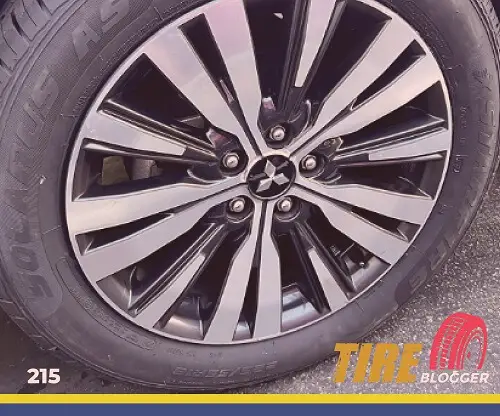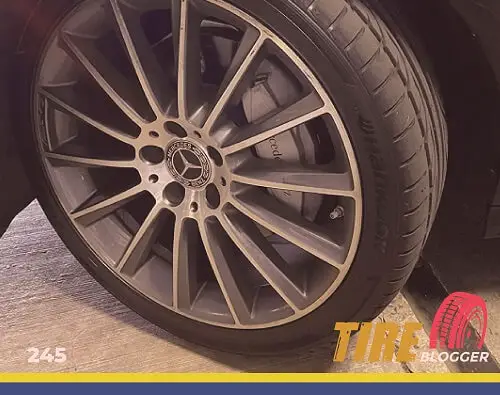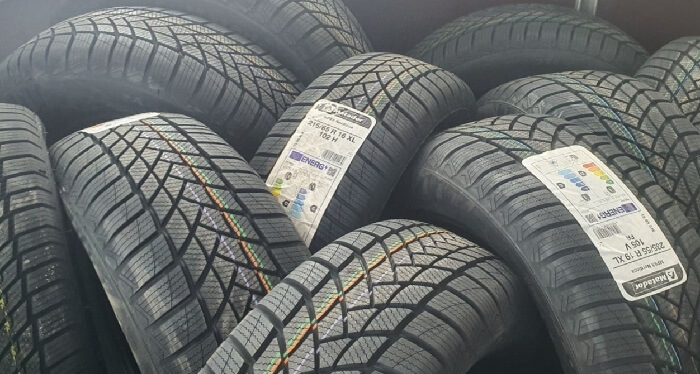215 vs 245 Tires

The main difference between a 215 tire and a 245 tire is the width – a 245 tire is 30mm (or about 1.18 inches) wider than a 215 tire. This wider tread provides more contact with the road surface.
215 vs 245 Table
By referring to this comparison table, you can easily understand the differences between the two tire sizes and quickly identify their distinctions.
| Tire Size 215 | Tire Size 245 |
|---|---|
| Narrower 8.46 inch tread width | 30mm (1.18 inches) wider 9.65 inch tread width |
| Slightly better fuel efficiency from lower rolling resistance | Slightly less fuel efficient due to wider tread |
| Transmits fewer vibrations on smooth roads | Absorbs vibration better with larger air volume |
| Quicker steering response and handling | Enhanced stability and traction |
| Can cut through snow more effectively | Improved performance in mud with larger contact patch |
| Streamlined appearance preferred by some drivers | Aggressive, widened stance preferred by others |
| Comparable lifespan with proper maintenance | Heavier weight adds more stress to components |
| Minor impact on speedometer accuracy | Larger diameter registers slightly slower speeds |
Ground Clearance
A 245 tire offers slightly more ground clearance than a 215 tire. The extra sidewall height raises the vehicle higher off the ground, which can help clear obstacles or rough terrain. However, the difference is minor – usually less than an inch.

Gas Mileage
The 215 tires provide slightly better gas mileage compared to the 245 tires. Their narrower tread results in less rolling resistance, allowing the engine to work a little less to move the vehicle. However, with proper inflation and alignment, the difference in fuel economy is marginal.
Ride Comfort
Both 215 and 245 tires can deliver a comfortable ride. The 245 tires absorb more vibration due to their larger air volume and sidewall height.
But on smooth roads, 215 tires transmit fewer vibrations. Overall, ride comfort depends more on tire construction and inflation than just width alone.
Aesthetics Look
Some drivers prefer the aggressive, widened stance of 245 tires, while others favor the more streamlined look of narrower 215 tires. This difference is mostly aesthetic preference. Wheel size plays a larger role in appearance than just 30mm of extra width.

Handling & Stability
The nimbler 215 tire provides responsive steering and handling, ideal for dry paved conditions. But the wider 245 tire offers enhanced stability and traction, performing better on loose or uneven surfaces. In everyday driving, the difference is subtle.
Noise & Vibration
The 245 tires produce slightly more road noise due to their wider tread. But their larger air chamber absorbs vibration better. Overall, quality tire construction has more impact on noise and vibration than the width difference between 215 and 245 tires.
Durability & Wear
With proper maintenance, both tire sizes exhibit comparable lifespan. The 245’s heavier weight can add more stress to suspension components.
But its bigger footprint distributes wear more evenly across the tread. Again, construction and inflation matter most for durability.

Adverse Conditions
The 245’s large contact patch provides better traction in snow or mud, though very wide tires can sometimes “float” on soft surfaces.
The 215’s narrower tread tends to penetrate snow better. For mixed weather driving, all-season tires in either size perform well.
Speedometer
When switching between tire sizes, a 245 will register a slightly slower speed than a 215 due to its larger diameter. This minor difference has a negligible impact on speedometer accuracy for everyday driving. But for precise measurement, the speedometer can be recalibrated.
Difference Between 215 and 245 Tires
The primary difference between 215 and 245 tires is the section width, with 245 tires being 30mm wider than 215 tires. This difference in width affects various aspects of tire performance and handling characteristics.

Can I Replace 215 Tires With 245
Yes, you can replace 215 tires with 245 tires. The ideal rim width range for 215 tires overlaps with the range for 245 tires, making the switch possible. Yet, there are crucial aspects to bear in mind.
Notably, the new tires’ aspect ratio and rim diameter should be consistent with your existing configuration. If these dimensions differ, keep the overall diameter difference at 3% or less to avoid impacting speedometer precision and vehicle operation.
Can I Put 245 Tires on 215 Rims?
Yes, you can put 245 tires on rims designed for 215 tires. The ideal rim width range for 215 tires (6.5-8.0 inches) overlaps with the range for 245 tires (7.5-9.0 inches), ensuring proper fitment.
Can I Replace 245 Tires With 215?
Yes, it is possible to replace 245 tires with 215 tires. The ideal rim width range for 245 tires (7.5-9.0 inches) overlaps with the range for 215 tires (6.5-8.0 inches), making the switch feasible.
However, keep in mind that the aspect ratio and rim diameter of the new tires should match your current setup. If the aspect ratio or rim diameter does not match, then the overall diameter difference should stay within 3% to avoid affecting speedometer accuracy and vehicle performance.

Can I Put 215 Tires on 245 Rims?
Yes, you can put 215 tires on rims designed for 245 tires. The ideal rim width range for 245 tires (7.5-9.0 inches) overlaps with the range for 215 tires (6.5-8.0 inches), ensuring proper fitment and performance.
Our Observation
After comparing 215 and 245 tires, I’m struck by how minor the differences are between these two common sizes. Besides the 30mm width increase, 245 tires provide only subtle advantages in ground clearance, traction, and vibration dampening.
For most drivers, either width seems suitable for daily use. Personally, I prioritize fuel efficiency, so I favor the slimmer 215 to eke out those extra miles per gallon. But I can see the benefit of 245 tires’ stability and traction for off-road adventures.
While width plays a role, I’m learning that aspects like construction, tread pattern, and maintenance matter more than those 30mm for performance. The best tire depends on your priorities as a driver.

Meet Caitlin McCormack, a Tire Size Expert and Blogger Passionate About Everything Related to Tires. With Years of Experience in the Tire Industry, Caitlin Has Become an Expert in Tire Sizes and Their Impact on Vehicle Performance.
